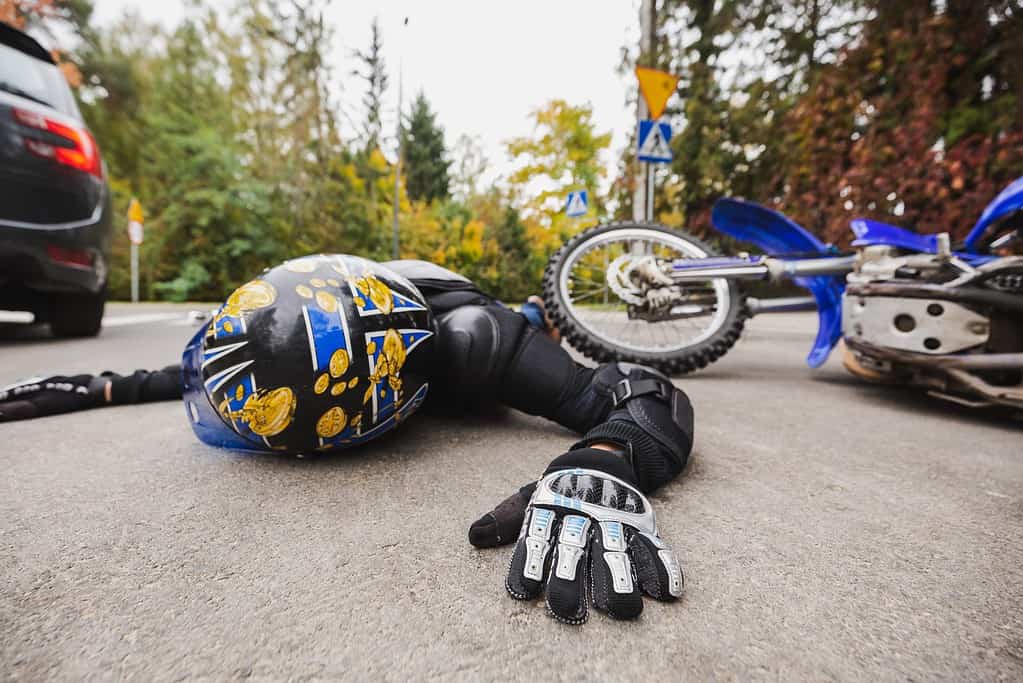Motorcycle accidents are tragic sometimes, and one cannot help but feel despair when you witness one on the road. That’s because most of us understand how fatal motorcycle accidents are!
Here is the problem- motorcycle riders have a bad reputation. Society is quick to blame the rider when an accident happens due to the false assumption that all riders are adrenaline junkies who ride too fast.
The truth is quite the opposite, though. Most motorcyclists value their life and safety. They are cautious of the dangers while riding and obey traffic laws.
Sadly, even their best efforts may not be enough. Most often than not, the main source of liability in motorcycle crashes is drivers of other vehicles.
So then, what percentage of motorcycle accidents are the rider’s fault? Let us find out.
What Do the Statistics Say About Fault in a Motorcycle Accident?
The Hurt Report, published by the National Highway Traffic and Safety Administration (NHTSA), is the most comprehensive study on motorcycle use and accident statistics.
The study focused on 900 motorcycle accidents to determine their causes; it found that motorcyclists are not usually at fault for motorcycle accidents.
Even though the NHTSA published this report in 1981, the information and statistical data apply nationally and internationally today. The findings show that:
- In accidents between a motorcycle and another vehicle, the other vehicle was at fault for breaching the rider’s right of way in 66% of the accidents.
- The leading cause of the accidents was the other vehicle failing to see the rider.
- The most common type of accident was a collision with a vehicle turning left, accounting for 42% of all accidents.
- Over 50% of riders involved in accidents had five months or less of riding experience

So, even as drivers blame riders for being reckless on the road, this data proves otherwise. Most motorcycle accidents occur due to negligence from car drivers.
So, if you get into a motorcycle accident and sustain injuries, you have the right to pursue compensation against the at-fault driver. Get in touch with an experienced motorcycle accident attorney to help with your case.
What Percent of Motorcycle Accidents are the Rider’s Fault?
Other drivers’ actions are indeed the leading cause of motorcycle accidents. But that doesn’t mean riders are entirely off the hook.
There are instances when the motorcyclist is at fault for motorcycle accidents. So, what percent of motorcycle accidents are the rider’s fault?
Here are key NHTSA statistics to help us answer this question:
- About 35% of motorcycle accidents are single-vehicle, i.e., motorcycle only. Here, the rider is always at fault.
- ¼ of motorcycle deaths occur after collisions with fixed objects.
- 37% of riders involved in accidents are alcohol-impaired. Most of them are considered legally drunk.
- 34% of motorcycle accident fatalities happen when the rider is speeding.
- 24% of crashes involve riders with no current license.
In each of the above, the rider may be at fault. But remember, in most cases, the rider is powerless to stop the collision. That’s because other drivers could be inattentive or can’t correctly judge the bike’s speed.

Often, the car driver will pull out in front of the bike, and this doesn’t allow the biker enough time to slow or stop without the risk of flipping.
The bike collides with the other vehicle, and there is nothing much the rider could have done to prevent it- hence partial liability.
Why Do I Need to Prove Fault?
There are two avenues for pursuing a motorcycle accident compensation claim:
- First-party claim- No-fault accident benefits if residing in a no-fault state
- Third-party claim- Personal injury compensation claim against the at-fault driver
You don’t have to provide proof of fault for the motorcycle accident if pursuing a first-party claim. You can enjoy the insurance benefits irrespective of who caused the collision.
However, your insurance may not cover pain and suffering and other damages. So, to get fair compensation, you must file a tort claim against the party who caused the motorcycle accident. That’s where proving fault comes into play.
How Does One Determine Fault in a Motorcycle Accident?
Simply stating that the other vehicle’s driver was at fault for the motorcycle accident is not enough. You must provide testimony and evidence to support your claim.
Another thing, insurance adjusters are often biased in treating motorists, considering them inherently reckless. Based on this assumption, they can undercut or deny your claim against the negligent driver.
So, how do you determine who is at fault in most motorcycle accidents? Here are the steps to take:
1. The Police Report
When a motorcycle accident occurs, the police examine the scene to determine who is at fault. Traffic officers examine the vehicle damage and their respective post-crash positions, looking for skid marks and other physical evidence.
The at-fault party will receive a ticket in clear-cut situations like when the driver was running a red light. But in most cases, more investigation will have to be done to determine fault accurately.
2. Witnesses
The police then interview persons who witnessed the accident and include their statements in the report. However, it’s advisable to get the contact information of each witness.
Your lawyer may want to interview them later to verify your event accounts.
3. Security Cameras
These are not always available. But determining who was at fault would be much easier if you could get the footage from security and traffic cameras near the accident scene.
4. Insurance Adjusters
Insurance companies investigate an accident on their own. This is particularly true when the company represents the at-fault car driver.

So, taking pictures of the accident scene and the vehicles involved is crucial. Also, collect other evidence that could be useful, such as witness contact information.
5. Admission of Fault
Either of the two parties might accept responsibility for the accident. But if you ever find yourself in an accident, never admit fault. You cannot reverse it if you admit fault, even by mistake.
The best thing to do is avoid discussing the accident with anyone until you consult an experienced motorcycle accident attorney.
What Does Insurance Say About Fault?
After a motorcycle accident, insurers try to determine which party was at fault. The insurance companies (for both parties) launch their investigation to know how the accident happened and who caused it.
Insurance firms apply comparative fault laws to determine whether or not to compensate for the damages. So, even if found to be partially at fault, you can still be eligible to recover funds through a claim.
Some states have laws allowing apportionment of liability. If the jury finds you 20% responsible for your accident, you will be entitled to 80% of the damages incurred.

For example, if your claim is $10,000 and the insurance company found you 20% at fault, you will be paid $10,000 less than $20% of the claim. That means you will receive $8,000 from the other party for your injuries and damages.
Remember, every state has its laws. In some, you can receive damages even if the other party was 1% responsible for the accident. However, in other states, you are not eligible to recover any funds if you are more than 51% at fault for the motorcycle accident.
How Is Fault Proven in Motorcycle Accidents?
If you wish to prove fault in a motorcycle accident, you must show that the at-fault party was negligent. Negligence consists of four main features:
- Duty: The duty of care is the other’s party’s legal obligation to act responsibly when on the road. It would be easy to prove if another driver hits you because all motorists owe a duty to care.
- Breach of duty: Evidence should show that the other party violated their duty of care to you. Speeding or not following traffic rules are examples of the breach.
- Causation: Evidence must explain how the at-fault party’s negligence triggered the accident, leading to injuries.
- Damages: You must show proof of injuries and other damages sustained due to the accident (medical bills, lost wages, etc.).
Hiring an experienced lawyer to help with your case can ensure you meet all the above requirements for proving negligence.
Get Legal If You Have Been Involved In a Motorcycle Accident
More often than not, motorcycle accidents result from negligence from other motorists. Suppose the police officer investigating your case finds the car driver was partially or totally at fault for the accident with your motorcycle. In that case, you can rightfully claim compensation for your injuries.
It would be best if you had a lawyer to increase your chances of winning the case.
At Legal Giant, we have the best team of attorneys handling personal injury cases. We take pride in helping victims of personal injury, and traffic accident cases receive fair compensation.
Contact us today for a free, no-obligation evaluation of your case.

